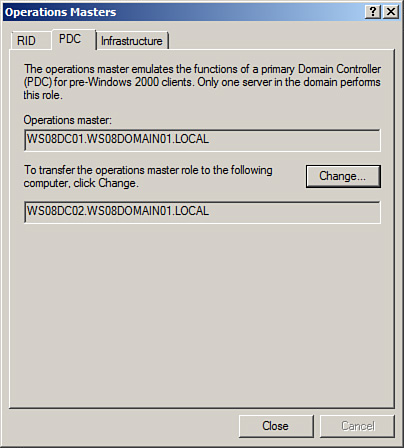Scenario/Problem: Each
Active Directory Domain Services domain has a single domain controller
that is configured as the PDC emulator. The PDC emulator is ultimately
responsible for password changes, validating authentication failures,
account lockouts, and synchronizing the time. By default, this role is
enabled on the first domain controller you add to a domain.
Solution: The PDC emulator operations master role can be transferred by using the Windows interface or the command line.
Transfer the PDC Emulator Role by Using the Windows Interface
To transfer the PDC master role by using the Windows interface, perform the following steps:
1. | Log on to a domain controller or a member computer that has Windows Server 2008 RSAT installed.
|
2. | Click Start, click Administrative Tools, and click Active Directory Users and Computers.
|
3. | Right-click the domain node in the console tree and select Change Domain Controller.
|
4. | On
the Change Directory Server page, select the domain controller to which
you want to transfer the PDC master role, and click OK.
|
5. | Right-click the domain node in the console tree and select Operations Masters.
|
6. | On the Operations Masters page, select the PDC tab, shown in Figure 1.

|
7. | Ensure the domain controller you selected in Step 4 is listed as the targeted server and click Change.
|
8. | On the confirmation page, click Yes.
|
9. | A message displays that indicates the operation completed successfully. |
Transfer the PDC Emulator Role by Using the Command Line
To transfer the PDC master role by using the command line, perform the following steps:
1. | Log on to a domain controller.
|
2. | Click Start, and click Command Prompt.
|
3. | In the Command Prompt window, type ntdsutil and press Enter.
|
4. | At the ntdsutil command prompt, type roles and press Enter.
|
5. | At the fsmo maintenance command prompt, type connections and press Enter.
|
6. | At the fsmo maintenance command prompt, type connect to server
DomainController, where DomainController is the domain controller to which you want to transfer the role, and press Enter.
|
7. | At the server connections command prompt, type quit and press Enter.
|
8. | At the fsmo maintenance command prompt, type transfer PDC and press Enter.
|
9. | On the Role Transfer Confirmation page, click Yes to confirm the transfer.
|